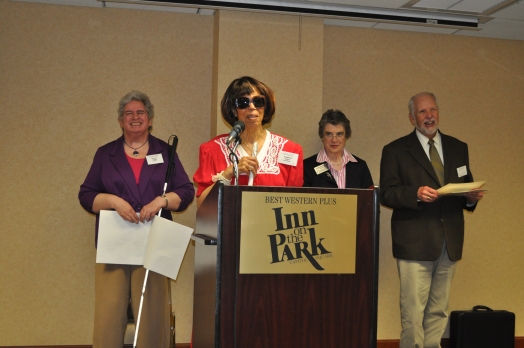
Council Board member Deen Amusa presented Dave Schuh with the 2014 Friend of the Council award.
Dave Schuh, owner of Accessibility Pros LLC, has been dubbed “Wisconsin’s adaptive technology guru to the disability community” by the person who nominated him for the 2014 Friend of the Council Award. It’s easy to see why.
Dave has vision loss from Retinitis Pigmentosa, so he understands firsthand the challenges of the people he works with face. For 10 years, he served as an assistive technologist at a local technical college in Wausau where he taught technology to students with vision loss and other disabilities. “With a Master’s in Computer Information Systems and being visually impaired myself, I had extensive knowledge with accessible technology. I used screen reading programs, magnification programs and accessible books everyday, and I could help students with practical applications for school and work.”
Setting out on his own
Dave’s other master’s degree is in business administration. In 2005, he launched his own business. “It was challenging to start my own business, but I was good at assistive technology, and I relate well to people. I thought I might serve as a role model for others who have disabilities.”
Dave’s office is conveniently located in his Wausau home where he offers a lot of his training. Most of his clients live in northcentral Wisconsin; however, some live in other locations like Eau Claire, Green Bay and Rhinelander. A typical training session lasts three to four hours. If someone has traveled a considerable distance, the training session could be modified to meet the person’s needs. To provide additional flexibility and convenience, Dave also provides training at a person’s home or work site.
Individualized instruction for people with vision loss
Part of Dave’s success is that he tailors technology training to the needs of each person. “I begin by asking the person what he or she wants to accomplish.” He has helped one writer convert files, import images and do routine editing. Right now, a few of his clients want to become human service professionals, so he is teaching them how to work with online resources and report writing using various types of assistive technology. Dave sees a number of older adults who have recent vision loss and who need to learn computer basics such as keyboarding, word processing and
E-mail. These individuals use their new skills for going back to school or for a different job. He also has opened up the wide world of reading for many people who thought they had to give up this pastime. His youngest client was 7 years old and his oldest one was 92. “A lot of my clients are students, and there are others who have lost jobs because of an injury or health issue. Assistive technology training helps them remain competitive in the marketplace.”
The importance of a positive attitude
Dave knows it can be a challenge when a person loses part or all of his or her vision. He recounts, “When I was losing my sight, I was concentrating on what I couldn’t do anymore, not on what I could do. A skiing experience at the Colorado Ski School for the Blind for a week in Vail, Colorado, totally changed my outlook. I was able to do something very challenging. If I could do that, then I knew that I could push myself to do new things. I realized that there’s a lot I haven’t done yet and that I still want to do.”
In addition to his computer training background, Dave brings another important skill to the work that he does—listening. “I listen to each person’s story and I ask questions to help him or her determine the kind of training needed. I think people are encouraged by me because they see that I have vision loss AND I have a successful business, a family and a nice home. I encourage people to focus on what they can do and build on their past experience.”
When Dave’s not helping people with vision loss
Dave’s clients might be surprised to learn that he and his wife Donna are ballroom dancers. “It all began with five dance lessons before our daughter’s wedding. Donna and I have been dancing for almost five years now, and this year, we competed in three national dance competitions. People didn’t know I had vision loss until I walked with my dog guide around the ballroom after we competed!”
In his work, Dave has dispensed valuable advice because he understands many of the feelings that individuals with vision loss are experiencing. “I wish more people knew about all the resources that are available, including the programs and services of the Wisconsin Council of the Blind & Visually Impaired.”
It’s a job Dave loves
Dave enjoys getting to know each person with whom he works and helping them reach their personal goals. “The best part of my job is being able to make a difference in the lives of others. Nothing beats that!”











